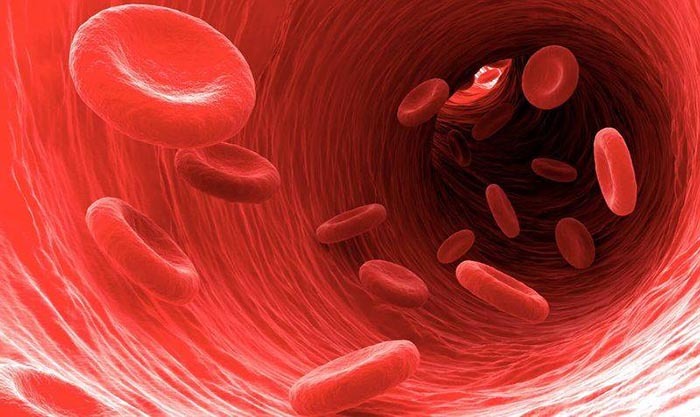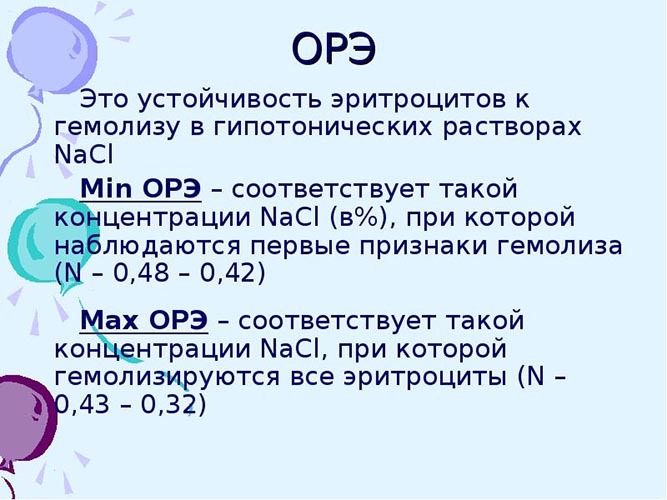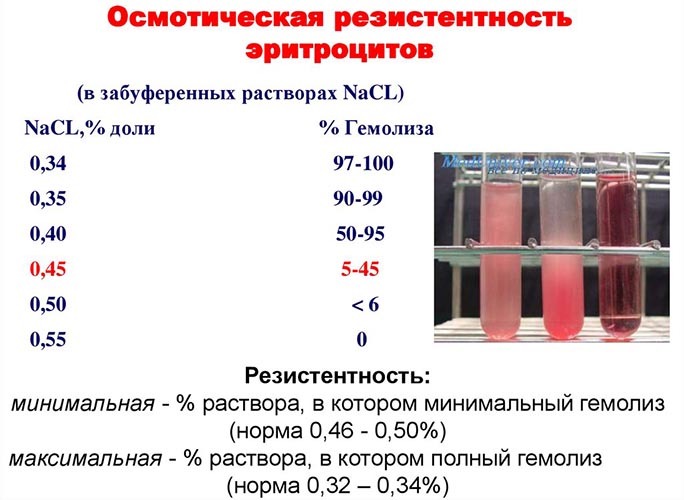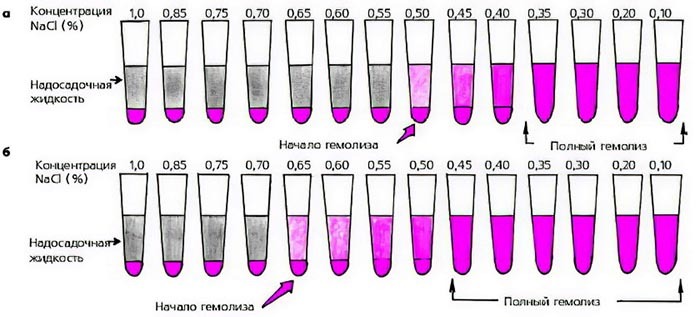Content
- What is WEM
- Method for measuring osmotic resistance
- Preparing for the procedure
- Signs of violation of the WEM
- Reasons for violations
- Dependence of membrane stability on various factors
- Resistance rate
- Counting the number of red blood cells
- Erythrocytometry
- Video about WEM
Blood cells or red blood cells- these are the most important components of the blood that can capture molecular oxygen particles, after which, - transport them to the desired tissues of the whole organism. For the study of bodies, osmotic resistance is used, which is the ratio of the resistance of the outer shell of erythrocytes to the external saline environment.
What is WEM
Red blood cells or red blood cells are the most abundant cellular structure in human blood. The functional feature of the membrane makes it possible to assign individual oxygen molecules to the serum, which are subsequently transported to organs and tissues.
In the case of the development of dangerous pathological or degenerative processes, the membrane shell malfunctions, which causes dysfunctions of erythrocytes, which become less resistant to destruction.

Such changes are most often characterized by a significant decrease in the total number of blood cells, which provokes a rapid violation of the oxygen-water exchange of the tissue structures of the body.
The functional features of the membrane walls, which make it possible to resist the destruction of red blood cells in the blood, in medical practice are called the term "resistance".
Many diagnostic measures aimed at identifying degenerative processes in the blood and identifying the underlying pathology are characterized by the presence of osmotic resistance of erythrocytes or BRE.
Such an indicator is able to determine the stability and preservation of the cell wall of blood cells under various unfavorable factors, including changes in the volume of dissolved salts.
Method for measuring osmotic resistance
Osmotic resistance of red blood cells is a diagnostic procedure that allows you to timely identify the pathological process and actively eliminate it.
Since the cellular structure of blood normally functions only in an isotonic solution, where the content ion molecules cannot exceed 0.85%, degenerative changes are characterized by an increase or decrease indicator.
Solutions that contain an excessive amount of organic salts are called in medical practice hypertensive, as well as hypotonic in the case when the substances are much less than the normative indicator. If you put the cell membrane in such substances, it will quickly collapse under the influence of chemical processes.

The blood cells of a healthy patient can withstand almost any osmotic pressure, which gives them additional protection, visually reminiscent of the outer protein shell.
In order to determine such resistance, doctors use a technique in which:
- A solution of ion molecules with different concentrations is added to different test tubes, from the highest 0.7% to the lowest - 0.20%.
- The solution is supplemented with a small volume of blood serum, the total amount of which should not exceed 0.02 ml.
- For 1 hour, the tubes are kept in a special reservoir with a temperature support of 22-24 ° C.
- The resulting substance is centrifuged, after which, based on the main shade and molecular content, it is calculated the approximate time after which the process of destruction of the cellular structure of erythrocytes begins, before their final hemolysis.
If a pinkish tint signals the onset of destruction of erythrocyte cells, then bright red is determined as a complete breakdown of erythrocytes. Depending on the nature of the molecular analysis, the main factors contributing to the degenerative processes are determined.

Using this type of examination, doctors can determine both the maximum and minimum osmotic resistance of red blood cells. All of them are determined based on the high or low content of ions in the substance. The minimum amount is characterized by only slight destruction, which most often does not differ in further progression.
Preparing for the procedure
The main source of any information about the resistance process is the tubes to which the anticoagulant or test substance is added. Such a technique is practically unmistakable, however, it requires some preparatory measures from the patient.
First of all, you should pay attention to the fact that the level of erythrocyte resistance in a child differs greatly from that of adult patients. In children, the normative indicator is much lower, at the same time, in the elderly it is higher by 10-15%.
In medical practice, it is customary to highlight some factors that may interfere with the correct interpretation of the analysis.
The most popular are:
- recent blood transfusion or purification, which indirectly affects the number of blood cells, and can also modify the functional features, up to a persistent decrease in the protective reaction of the membrane by 2-3 days;
- the presence in the taken substance of various pathogenic or bacterial microorganisms that provoke the development of hemolysis of the cellular structure. This feature is typical for inflammatory reactions of any nature, including degenerative changes in human bone tissue. Often accompanied by a significant decrease in plasma clotting;
- the presence in the patient's history of certain pathological processes of an acute or inflammatory nature, which can reduce the total volume of red blood cells in the blood. In this case, the most common cause is the rapid development of anemia;
- the human factor in the face of careless handling of the test samples, which can cause a premature hemolysis process. In this case, an incorrect diagnosis is often made, after which a therapeutic course is prescribed, which can only harm a person with a falsely diagnosed disease.

If the above reasons were excluded, which may indirectly affect the effectiveness of the study, but at the same time patient, there is a significant deviation from the standard indicator, this indicates the presence of a serious pathological process. Such diseases often affect the metabolic function and cause various unpleasant symptoms.
Signs of violation of the WEM
The most obvious sign of a pathological process in the body with a decrease in the WEE indicator is a lack of appetite, which is accompanied by a significant loss of body weight.
Osmotic resistance of erythrocytes is, although the most effective diagnostic method, in some cases the development of symptoms is possible even before the manifestation of metabolic disorders. This is due to the functional features of the blood, which, even with a slight decrease in the number of red blood cells, has a detrimental effect on the body.
The main signs of such pathological processes:
- increased sleepiness or insomnia;
- depression, accompanied by psychoemotional mood swings, depression and a significant deterioration in human life;
- anemic symptoms localized in the mucous membranes;
- high body temperature, chills and convulsive manifestations;
- increased pallor of the skin;
- exacerbation of pathologies of a chronic nature.
The above symptomatic signs should be the basis for an immediate appeal to the attending specialist. After that, the patient is referred for general biochemical diagnostics. The earlier the main diagnosis is made, the better the prognosis for recovery, and the less harm will be done to the human body.
Reasons for violations
The standard indicator of the WEM is able to change due to certain pathological processes, both chronic and acute.
Changes in the level and percentage of red blood cells are observed in the following diseases:
- Strong increase. Malignant neoplasms, diseases of a diffuse nature, affecting any connective tissue, infectious and bacterial pathologies, renal failure with the simultaneous development of nephrotic syndrome. An increase in TRE can also be observed with hereditary vitamin anemia.
- Moderate increase. Most often, the causes include diseases of an acute and chronic nature, local purulent education, myocardial infarction, as well as diabetes mellitus, general intoxication of the body and the presence of internal bleeding. In some cases, the development of leukemia, tuberculosis or cirrhosis of the liver is possible.
- Decrease in the indicator. Here, the most common causative factors are: acute heart failure, erythremia, as well as symptomatic manifestations of erythrocytes, which are caused by a genetic factor. Also, diseases in the gastrointestinal tract can often lower the level of BRE.
Determine the main cause of deviations in the standard indicator can only be carried out by a set of diagnostic measures. Individual studies most often do not play any role, because in this case, incorrect interpretation of the results is possible.
Clinical symptoms are most often determined by a specific disease, therefore there are no general signs that would be characteristic of a decrease or increase in the indicator.

Often, the patient complains of the following symptoms, which are common to many pathological processes that affect the level. If, in the case of a diagnosis, the presence of a certain disease is established, it is necessary to urgently start its treatment, since many of the characteristic diseases pose a particular danger to the whole organism.
Osmotic resistance of erythrocytes is such an indicator, the treatment of which is based on the elimination of the main pathological process. Therapeutic procedures in this case are both radical and conservative. Forecasting is strictly individual, which depends on many factors and indicators.
Dependence of membrane stability on various factors
The level of density of the outer membrane of the membrane increases or decreases not only due to the age of the cell structure, but also its shape. A healthy red blood cell, which has already been fully formed, is a disc bent inward, and can there are other forms that are characterized by degenerative lesions: lunar, sickle, spherical or star-shaped.
For a particular pathological process, pathological changes in the cellular structure are characteristic, which is characterized by an increase or decrease in the WEE indicator. So, with diagnosed sickle-shaped anemia, erythrocytes appear in the form of sickles, but most of the known anemic diseases are characterized by a spherical shape.
Only those erythrocytes that are made in the form of a disc have a natural and healthy resistance of the membrane walls. Blood cells with different visual characteristics are most often characterized by various degenerative changes that can affect the resistance process.

The cell structure, made in an oval shape, often cannot fully fulfill its main function, while this type is found both in sick people and in the elderly. This feature is explained by the fact that blood cells become more rounded and elongated with aging.
Based on the above, healthy and pathologically correct cells are young erythrocytes, which have a pronounced disk-like shape. In this case, various degenerative disorders in the body that affect resistance are practically absent.
Many experts and scientists working on longevity suggest that given special equipment in the future that can modify the red blood cell, it will be possible to increase the number of centenarians throughout planet.
Resistance rate
Failure to comply with the resistance indicator is characterized by its increase or decrease, which manifests itself in the case of the development of a dangerous disease in the patient's body. So, even the smallest deviation indicates a high risk of a severe pathological process, therefore, diagnostic procedures are carried out at the entire stage of treatment.
For an adult, the norm of the indicator ranges from 0.46 to 0.48 percentage units in the case of minimal resistance and from 0.32 to 0.34 in the presence of a maximum level. This feature determines the functional properties of blood cells, depending on the type of solution.

Since resistance in children is most often increased, and in elderly patients it is slightly below the average norm, the patient's age must be taken into account in any case.
The presence of malformed erythrocytes in the blood plasma due to a genetically determined process does not imply additional diagnostics and treatment. In this case, the main thing is to support the body, observing the basic prophylactic recommendations.
It should also be remembered that some types of anemic diseases are characterized by the absence of deviations from the standard indicator, which cannot be shown by analysis. So, despite the fact that insufficient activity of erythrocyte molecules is diagnosed normally, the patient has symptomatic manifestations of anemia.
In addition to anemic disease, a decrease in the indicator is characteristic of general intoxication of the body with the help of lead or mercury compounds. In more rare cases, an increase in PRE occurs due to vitamin deficiency or with an acute hemolytic crisis.
Counting the number of red blood cells
In addition to a comprehensive study of blood serum and the BRE indicator, in medical practice it is often another type of diagnosis is used, which allows you to display the exact number of blood cells in the body. Since various pathological processes lead to a decrease in the volume of red blood cells, such a study takes place.
For accurate counting of red blood cells, a counting chamber is used, into which human blood is injected. The chance of error is about 2%, which is much lower with other research methods.

Incorrect interpretation is most often due to the presence of clots in the plasma, non-observance of all the rules of conduct, and also due to the uneven filling of the research device. If the specialist does not wait 2-3 minutes. (the time at which the red bodies have time to settle), the chance of making a mistake in the calculation is about 70%.
Osmotic resistance of erythrocytes is an indicator that can be detected using 2 diagnostic techniques, where the main focus of the study is aimed at counting the number of red cells:
| Methodology | Description, details |
| Photometric technique for calculating the total volume | It is based on a photometric type of measurement, which can calculate the exact number of bodies by exposure to certain waves, most often light. The percentage of light retained is precisely related to the quantitative volume of the bodies. For this, devices such as electrophotocolorimeters or erythrohemometers are most often used. |
| Autonomous electronic method. | In this case, the specialist uses devices that allow you to automatically count the erythrocytes in the blood. Such devices operate on the principle of scintillation and impulse interaction, which makes it possible to accurately determine the total volume of the investigated particles. |
Deviations in the quantitative indicator are possible in the presence of such pathological processes as erythremia, hypoxia or hemoglobinopathy. Also, the volume of red blood cells can be reduced due to the presence of malignant tumors in the liver and kidneys, including polycystic disease.
A relative decrease in the total number of blood cells is observed in the case of exposure to stressful situations, severe alcoholism, as well as dehydration or severe physical exertion.
Erythrocytometry
Osmotic resistance can deviate in the case of another indicator - the diameter of red blood cells, which can be investigated by a diagnostic procedure called erythrocytometry. This study allows you to accurately determine the shape of the blood cells, which indirectly affects the development of the pathological process in the body.
Changes in the diameter of red blood cells are diagnosed by a specialist using a visual-graphic image, on the basis of which a shaped model of blood cells is built.
With standard indicators, the erythrocytometric curve has the correct shape, the base of which is characterized by a narrow appearance. The results of this type of study are especially important in the case of clarification of anemic disease, in which more than 40-60% of blood cells have degenerative changes in the external structure.

The histogram, which indicates the distribution of blood cells in the blood, takes into account characteristics such as the volume, number and shape of red blood cells. Such a complex of research allows the doctor to more accurately determine the underlying disease, after which - to prescribe an effective course of treatment.
A diagnostic method that allows you to accurately calculate the indicator of osmotic resistance in erythrocyte tissues is especially important research to identify dangerous pathological processes, including anemia, cancers and others disease.
If the first symptoms occur, you should immediately contact your doctor who can send you for the necessary tests.
Video about WEM
Procedure for determining the osmotic resistance of erythrocytes:



